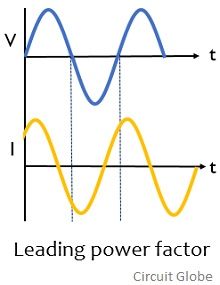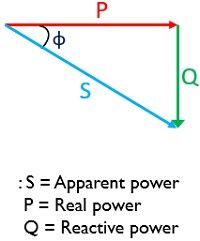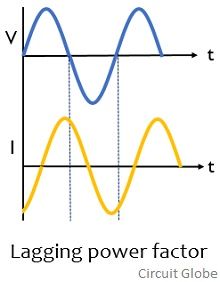Leading and lagging power factors are the two major terms associated with the power factor of the AC electrical system. The crucial difference between leading and lagging power factor is that in case of leading power factor the current leads the voltage. As against in case of lagging power factor, the current lags the supplied voltage. The tendency of the circuit that causes the current to either lead or lag depends on the load conditions.
What is power factor?
The power factor is a crucial property of AC electrical systems. It is dimensionless in nature. It is used for both single and three-phase AC circuits. It is the ratio of true or actual power to the apparent power in the ac systems.
In DC circuits one can evaluate the power of the circuit by finding the product of readings of voltmeter and ammeter. While in the case of ac circuit, this multiplication of these two provides the apparent power but, not the actual power. This is so because in ac circuits, the total supplied power i.e., the apparent power is not solely utilized by the circuit. And the actually utilized power by the circuit is referred as true power.
More simply, the power factor is the cosine of phase difference existing between V and I.
The power factor of ac circuits with linear loads lies between -1 to 1. Generally, it is considered that if a system exhibits a power factor closer to 1, then such systems are said to be stable. We will discuss the various factors that differentiate the leading power factor from that of lagging.
Content: Leading Vs Lagging Power Factor
Comparison Chart
| Basis for Comparison | Leading Power Factor | Lagging Power Factor |
|---|---|---|
| Basic | The load current leads the supply voltage by certain phase angle. | There is a phase difference between voltage and current where load current lags the supply voltage. |
| Nature of load in electrical circuit | Capacitive | Inductive |
| Correction of low power factor | By the addition of inductive load. | By adding capacitive load. |
| Value | Exists between -1 to 0. | Exists between 0 and 1. |
| Reactive component | Negative | Positive |
| Examples of respective loads | Capacitive load: Electrical motors, capacitor, radio circuits, etc. | Inductive load: Power generator, inductor, relays, etc. |
Definition of Leading Power Factor
The leading power factor in an ac electrical circuit is attained by the use of capacitive load in the circuit. As in the presence of a purely capacitive load or combination of resistive-capacitive load, the current leads supplied voltage. This gives rise to the power factor generally said to be leading in nature.
As it is known that the power factor is the ratio of true to the apparent power. And generally for sinusoidal waveform power factor is the cosine function of the phase angle existing between voltage and current. Consider the wave shapes of voltage supplied to the ac circuit and the current through the purely capacitive load:
As it is clear from the above figure that current, I encounter the 0 crossings of the time axis some phase earlier than that of voltage, V. This is referred as leading power factor. The figure below represents the leading power factor triangle:
Definition of Lagging Power Factor
In ac circuits lagging power factor, is achieved when the load is inductive in nature. This is so because when a purely inductive or resistive inductive load is present then there exists a phase difference between voltage and current in which the current lags the voltage. Thus the power factor of such circuits is of lagging nature.
Let us consider the waveforms of supplied voltage to an ac circuit and the current through the purely capacitive load as:
Here the current encounters the 0 crossings at some phase after the voltage. Thereby giving rise to a lagging power factor. The lagging power factor triangle is given below:

Key Differences between Leading and Lagging Power Factor
- The key factor of differentiation between leading and lagging power factor is that leading power factor is attained when the load current is in the leading position to that of the supply voltage. While lagging power factor shows that the current lags the voltage by some phase angle.
- When the load of the linear electrical network is capacitive in nature then it generates a leading power factor. As against when the load is of inductive nature then it results in lagging power factor.
- In the case of leading power factor, the phase angle of current is positive with respect to voltage. However, in the case of lagging power factor current phase angle is negative with respect to that of voltage.
- As the power factor is a crucial parameter of ac electrical circuits thus correction is quite necessary if the power factor is quite low. Thus a leading power factor is corrected by the addition of inductive loads. Whereas the correction in the lagging power factor is done by adding capacitive loads.
- In the case of the capacitive load, the load supplies reactive power. Thus the reactive component is negative as here the power is provided to it. But for inductive load, the load consumes reactive power, hence reactive component will be positive.
- The value of leading power factor i.e., with capacitive load ranges between -1 to 0. While for the lagging power factor i.e., with an inductive load, it lies between 0 and 1.
Conclusion
So, from this discussion, we can conclude that ideally it is assumed that voltage and current are in the same phase. Thereby having a phase angle of 0° between the two. However, a difference in phase exists between the two that is referred as the power factor of the circuit.




Good article, especially for students learning the basic principles of electrical engineering.
easy to understand and very useful.
tq for the content
Thank you the article was useful
Love the table. Very informative!
very good article but still being a beginner student of electrical i want to know about the generator power factor that either we should keep power factors in lag side or lead side which is better to draw ampere less
Thank you, very clearly explained, appreciate it.
Thank you very much it was very clear and helpful
Thanks for such a nice article. I got the knowledge after reading your article.